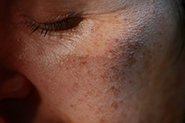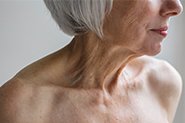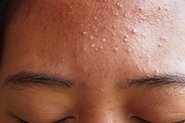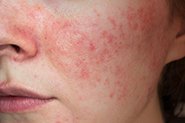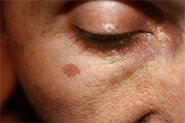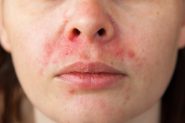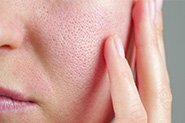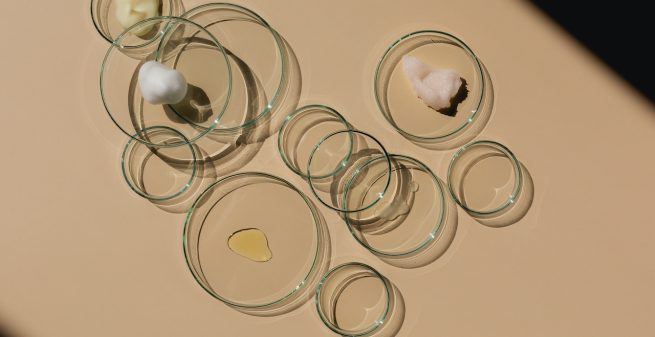
Hydroquinone suffers a severe case of bad PR! … Most people know about it being associated (very rarely!) with a type of HYPER-pigmentation called ‘Exogenous Ochronosis’ but can it destroy existing pigment in the skin and create white areas (called HYPO-pigmentation)? In this article Dr Michele explores the relationship between Hydroquinone and Hypopigmentation…
Hydroquinone (HQ) is the first line and gold standard treatment for melasma and hyperpigmentation. It’s a safe and effective treatment when used as prescribed by a trained and experienced doctor, and under close clinical supervision.
The most recognised (albeit extremely rare!) side effect of HQ use is something with the scary sounding name of ‘Exogenous Ochronosis’ (EO). This is a permanent blue-grey skin discolouration that causes a large amount of fear.
To provide some perspective around how frequently hypopigmentation occurs with hydroquinone, let’s first understand just how rarely the more common side effect, EO, is actually reported, and under what circumstances:
How common is EO? Let’s explore the scientific literature…
A 2007 systematic review identified 789 total EO cases reported worldwide since 1966.
Most cases were people who had used HQ continuously for years (not months of use as we prescribe).
95% (756/789) of these reported cases were from Africa where the nature of the HQ was unknown. This is because there’s a huge black market in skin ‘bleaching’ creams that can contain just about anything. This can include very high doses of HQ combined with other EO-causing ingredients like phenol and resorcinol. EO can also result from the use of antimalarial drugs, widely used in Africa.
Of the 137 cases that reported the concentration of HQ used, the majority (116) used a very low dose of 1-2%, but usage was unsupervised and excessive, with multiple daily applications
22 of these 789 cases were from the USA and involved the use of 1–2% hydroquinone used without supervision for years. These cases were reported from 1983–2006, which equates to 1 case per year, during which time an estimated 10–15 million HQ–containing creams/year were sold, making EO incidence 0.00022% to 0.0000067% during this period.
In a second study analysing 20,814 patients who were prescribed 2-5% topical HQ for 8 weeks to 2 years, and closely medically supervised throughout this time, there were ZERO reports of EO.
Now you know just how rare EO actually is, what about hypopigmentation?
An analysis of the scientific literature about hypopigmentation as a side effect of HQ use shows a similar pattern of unsupervised, non-medical use of potentially black market formulas (that could contain anything), and including use of hydroquinone in a work environment.
It is also reported when HQ has been used in conjunction with lasers/peels, which have a very high risk of hypopigmentation as they create intentional damage to the skin.
There have been 5 reported cases of hypopigmentation in total in the scientific literature, making it an extraordinarily rare side effect – way more so than the extremely rare side effect of EO.
But… If you Google HQ and hypopigmentation, some scientific references say they are related!
These are often referring to use of a derivative of HQ called Monobenzone. The other name for this is ‘Monobenzylether of Hydroquinone’ – and it can be easily confused for HQ itself.
Monobenzone is a drug intentionally used by doctors to permanently hypopigment (or depigment) skin when treating the skin disease vitiligo.
So, in these instances hypopigmentation is an intended side effect to even out the skin tone. We do not use this drug at Qr8.
Have you ever seen a case of EO or hypopigmentation at Qr8?
Since 2019, when our service launched, our doctors have treated thousands of patients of all skin tones with up to 12% hydroquinone daily and we have never had an incidence of EO or hypopigmentation.
Regardless, we are cautious of even rare side effects like EO and hypopigmentation, which is why our service is designed specifically to minimise irritation (trauma can result in death of melanocytes and hypopigmentation, which is why hypopigmentation is a common side effect of laser/peels).
We do this by carefully and slowly phasing your treatment in, providing information about skincare to support your treatment and reduce irritation, and closely supervise all patients using HQ, mandating 3 monthly checks with their doctor.
We also package our creams in medical-grade packaging to minimise oxygen exposure so they last for the 3 months of your treatment cycle, as a chemical formed by degraded hydroquinone (called ‘hydroxybenzoquinone’) can damage cells, leading to hypopigmentation.
We also send reminders so you can rebook with your doctor as your 3 month treatment period ends, to avoid you using expired and degraded creams, thereby potentially damaging your skin.
As an active patient, you also have access to our dermatology nurse either by text, email, phone or video, so can contact her if you are concerned about anything.
Our experienced dermatology nurse works with all Qr8 patients to create a simple, inexpensive and personalised skincare routine to support your treatment! Read more about how our fading treatments work HERE.
REFERENCES
- Levitt J. The safety of hydroquinone: a dermatologist’s response to the 2006 Federal Register. J Am Acad Dermatol. 2007 Nov;57(5):854-72. PMID: 17467115
- Tse TW. Hydroquinone for skin lightening: safety profile, duration of use and when should we stop? J Dermatolog Treat. 2010 Sep;21(5):272–5. PMID: 20095963
- Searle T, Al-Niaimi F, Ali FR. Hydroquinone: myths and reality. Clin Exp Dermatol. 2021 Jun;46(4):636-640. PMID: 33159818
WOULD YOU LIKE TO CHAT TO ONE OF OUR FRIENDLY DOCTORS ABOUT YOUR SKIN CONDITION?
CLICK HERE TO BOOK A CONSULT WITH OUR EXPERIENCED MEDICAL TEAM.


